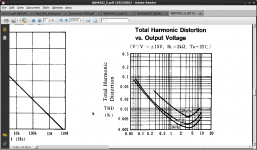one thing have always stopped me
the question... why bother building nice preamps and power amps, if they are connected through active xo built with 'questionable' components
but what is it other than rather simple buffers with resistors and caps ?
well, quite many buffers, and ofcourse all the control pots(attenuation)
the question... why bother building nice preamps and power amps, if they are connected through active xo built with 'questionable' components
but what is it other than rather simple buffers with resistors and caps ?
well, quite many buffers, and ofcourse all the control pots(attenuation)
NJM4560 is like NJM4558 on steroids: consumes more current, as the result is a bit faster and less distortions when loaded on the same resistance. One more version is NJM4562 that is faster because of different capacitance for compensation, for usage with amplification factor greater than 5. All of them were designed for audio, and all of them are still usable.
Speaking of class A bias, look at the graph attached: growth of THD with lowering output voltage (corresponds to decay of sounds that when decay have to sound softer, with less harmonics) is attributed by an output stage. Hence, biasing output stage we decrease this "backward" dependence of distortions on loudness, without the need for extra loop gain on higher frequencies that can lead to similar sonic results. As you may see, at 20 KHz and low output level THD is around -50 dB that can't be compensated by feedback because of not enough gain on this frequency. The result is harsh, "Solid state" sound. Contrary, this record was made from console that uses original 4558 biased in class A, it sounds "toobey". http://wavebourn.com/female_sample.mp3
Speaking of class A bias, look at the graph attached: growth of THD with lowering output voltage (corresponds to decay of sounds that when decay have to sound softer, with less harmonics) is attributed by an output stage. Hence, biasing output stage we decrease this "backward" dependence of distortions on loudness, without the need for extra loop gain on higher frequencies that can lead to similar sonic results. As you may see, at 20 KHz and low output level THD is around -50 dB that can't be compensated by feedback because of not enough gain on this frequency. The result is harsh, "Solid state" sound. Contrary, this record was made from console that uses original 4558 biased in class A, it sounds "toobey". http://wavebourn.com/female_sample.mp3
Attachments
Last edited:
- Status
- This old topic is closed. If you want to reopen this topic, contact a moderator using the "Report Post" button.
